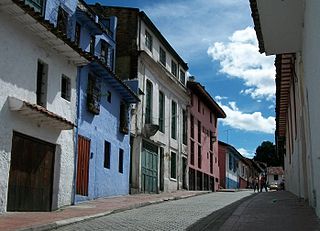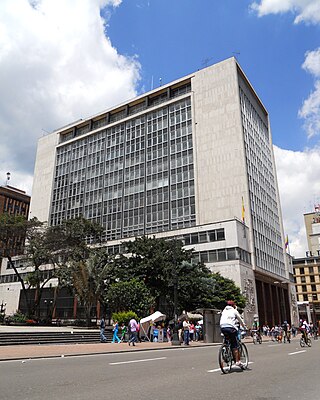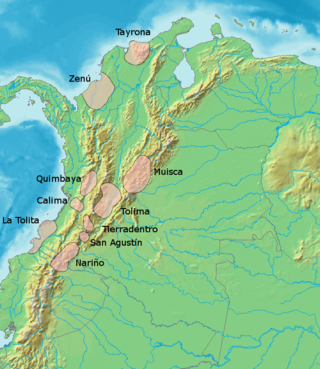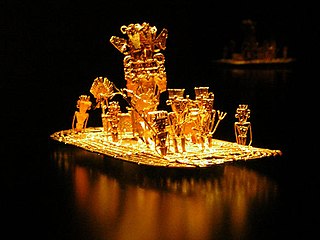
Santiago de Cali, or Cali, is the capital of the Valle del Cauca department, and the most populous city in southwest Colombia, with 2,227,642 residents according to the 2018 census. The city spans 560.3 km2 (216.3 sq mi) with 120.9 km2 (46.7 sq mi) of urban area, making Cali the second-largest city in the country by area and the third most populous after Bogota and Medellin. As the only major Colombian city with access to the Pacific Coast, Cali is the main urban and economic center in the south of the country, and has one of Colombia's fastest-growing economies. The city was founded on 25 July 1536 by the Spanish explorer Sebastian Belalcazar.

The Muisca are an indigenous people and culture of the Altiplano Cundiboyacense, Colombia, that formed the Muisca Confederation before the Spanish conquest. The people spoke Muysccubun, a language of the Chibchan language family, also called Muysca and Mosca. They were encountered by conquistadors dispatched by the Spanish Empire in 1537 at the time of the conquest. Subgroupings of the Muisca were mostly identified by their allegiances to three great rulers: the hoa, centered in Hunza, ruling a territory roughly covering modern southern and northeastern Boyacá and southern Santander; the psihipqua, centered in Muyquytá and encompassing most of modern Cundinamarca, the western Llanos; and the iraca, religious ruler of Suamox and modern northeastern Boyacá and southwestern Santander.

The Museum of Gold is a museum located in Bogotá, Colombia. It is one of the most visited touristic highlights in the country. The museum receives around 500,000 tourists per year.

Pasca is a town and municipality in the Cundinamarca department of Colombia located in the Andes. It belongs to the Sumapaz Province. Pasca is situated on the Altiplano Cundiboyacense at a distance of 71 kilometres (44 mi) from the capital Bogotá. It borders Fusagasugá, Sibaté and Soacha in the north, Bogotá D.C. in the north and east, Arbeláez in the south and Fusagasugá in the west. Is the entrance to the Páramo del Sumapaz, the biggest ecosystem in its genre in the world. The urban center is located at an altitude of 2,180 metres (7,150 ft) and the altitude ranges from 2,000 metres (6,600 ft) to 3,500 metres (11,500 ft).

The Archaeology Museum of Pasca is an archaeological museum located in Pasca, Colombia. It houses a great collection of Pre-Columbian objects and human remains, including Muisca mummies. It has a replica of the famous golden raft, Balsa Muisca, found near this town that represents the El Dorado rite. The museum hosts a piece of Muisca textile from Belén, Boyacá. The total collection numbers 2500 pieces. Apart from the Muisca artifacts, the museum hosts material from the Tairona, Calima, Quimbaya, Sinú, San Agustín and Tierradentro, among others.
Aníbal Villacís was a master painter from Ecuador who used raw earthen materials such as clay and natural pigments to paint on walls and doors throughout his city when he could not afford expensive artist materials. As a teenager, Villacís taught himself drawing and composition by studying and recreating the illustrated ad posters for bullfights in Quito. In 1952, Jose Maria Velasco Ibarra, former President of Ecuador, discovered Villacís and offered him a scholarship to study in Paris.

La Candelaria is the 17th locality of Bogotá, Colombia. A historic neighborhood in the city's downtown, it is the equivalent to the Old City in other cities. The architecture of the old houses, churches and buildings has Spanish Colonial Baroque, and art deco styles. It houses several universities, libraries and museums.

Malagana, also known as the Malagana Treasure is an archaeological site of Colombia named after a sugarcane estate where it was accidentally discovered in 1992. During the few days after its discovery, the place was subject to a large scale looting with a rough estimate of 4 tons of pre-Columbian artifacts illegally removed from the burial mounds. A rescue archaeological mission was sent by the National Institute of Anthropology and History (ICANH), led by archaeologist Marianne Cardale de Schrimpff. Archaeological excavations at the site established a previously unknown cultural complex, designated as Malagana-Sonsoid, that dates between 300 BC to 300 AD.

The Bank of the Republic is the central bank of Colombia. It was initially established under the regeneration era in 1880. Its main modern functions, under the new Colombian constitution were detailed by Congress according to Ley 31 de 1992. One of them is the issuance of the Colombian currency, the peso. The bank is also active in promoting financial inclusion policy and is a leading member of the Alliance for Financial Inclusion.

A Poporo is a device used by indigenous cultures in present and pre-Columbian South America for storage of small amounts of lime produced from burnt and crushed sea-shells. It consists of two pieces: the receptacle, and the lid which includes a pin that is used to carry the lime to the mouth while chewing coca leaves. Since the chewing of coca is sacred for the indigenous people, the poporos are also attributed with mystical powers and social status.

The Quimbaya (/kɪmbaɪa/) were a small indigenous group in present-day Colombia noted for their gold work characterized by technical accuracy and detailed designs. The majority of the gold work is made in tumbaga alloy, with 30% copper, which colours the pieces.

Calima culture is a series of pre-Columbian cultures from the Valle del Cauca in Colombia.

The Muisca raft, sometimes referred to as the Golden Raft of El Dorado, is a pre-Columbian votive piece created by the Muisca, an indigenous people of Colombia in the Eastern Ranges of the Colombian Andes. The piece probably refers to the gold offering ceremony described in the legend of El Dorado, which occasionally took place at Lake Guatavita. In this ritual, the new chief (zipa), who was aboard a raft and covered with gold dust, tossed gold objects into the lake as offerings to the gods, before immersing himself into the lake. The figure was created between 1295 and 1410 AD by lost-wax casting in an alloy of gold with silver and copper. The raft was part of an offering that was placed in a cave in the municipality of Pasca. Since its discovery in 1969, the Muisca raft has become a national emblem for Colombia and has been depicted on postage stamps. The piece is exhibited at the Gold Museum in Bogotá.

Quimbaya artifacts refers to a range of primarily ceramic and gold objects surviving from the Quimbaya civilisation, which was one of many pre-Columbian cultures of Colombia inhabiting the Middle Cauca River valley and southern Antioquian region of modern day Colombia. The artifacts are believed to have originated during the Classical Quimbaya period 500 BC–600 AD.

The Botero Museum also known as Museo Botero is a museum located in Bogotá, Colombia. It houses one of Latin America's most important international art collections. It sees over 500,000 visitors annually, and of those 2,000 students per month. Being in La Candelaria neighborhood of Bogotá, the museum is in close proximity to other important landmarks like the Luis Ángel Arango Library and the Gold Museum of Bogotá.

A tunjo is a small anthropomorh or zoomorph figure elaborated by the Muisca as part of their art. Tunjos were made of gold or tumbaga; a gold-silver-copper alloy. The Muisca used their tunjos in various instances in their religion and the small votive offering figures have been found in various places on the Altiplano Cundiboyacense, Colombia. Tunjos were used as offer pieces, to communicate with the gods and when the Muisca asked for favours from their deities. Muisca scholar Pedro Simón wrote about the tunjos of the Muisca.

This article describes the economy of the Muisca. The Muisca were the original inhabitants of the Altiplano Cundiboyacense, the high plateau in the Eastern Ranges of central present-day Colombia. Their rich economy and advanced merchant abilities were widely known by the indigenous groups of the area and described by the Spanish conquistadores whose primary objective was the acquisition of the mineral resources of Tierra Firme; gold, emeralds, carbon, silver and copper.

Marianne Vere Cardale de Schrimpff is a Colombian anthropologist, archaeologist, academic and writer.

This article describes the art produced by the Muisca. The Muisca established one of the four grand civilisations of the pre-Columbian Americas on the Altiplano Cundiboyacense in present-day central Colombia. Their various forms of art have been described in detail and include pottery, textiles, body art, hieroglyphs and rock art. While their architecture was modest compared to the Inca, Aztec and Maya civilisations, the Muisca are best known for their skilled goldworking. The Museo del Oro in the Colombian capital Bogotá houses the biggest collection of golden objects in the world, from various Colombian cultures including the Muisca.

The pre-Colombian cultures of Colombia refers to the ancient cultures and civilizations that inhabited Colombia before the Spanish Conquest in the 16th century.

















